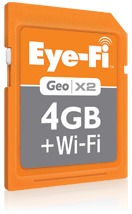Eye-Fi Updates Geo Card for Apple and Adds Hotspots
Eye-Fi has updated the Wi-Fi SD camera card that it sells exclusively via Apple Stores with double the memory and a number of other features. The new Geo X2 card has 4 GB of storage and will cost $69.99 when it becomes available for purchase in May 2010. The Eye-Fi Geo X2 works with Mac OS X software to transfer photos directly into iPhoto.
Eye-Fi embeds a processor, Wi-Fi radio, and storage in the tiny SD form factor. The card operates independently of the camera in which it’s inserted, using Wi-Fi to transfer images and videos to a computer running Eye-Fi software on the local network and/or uploading to online storage and sharing sites directly. It can also transfer to a file server via FTP and SFTP.
This latest Geo model for Apple is part of a revision in speed, capacity, and features that the company mostly released in March 2010 with its new X2 series of cards. The Connect X2 ($49.99, 4 GB), Explore X2 ($99.99, 8 GB), and Pro X2 ($149.99, 8 GB) each come with a slightly different set of features.
All X2 cards include 802.11n networking for faster data transfer, as well as a feature Eye-Fi dubs “Endless Memory.” With this option enabled, the cards automatically delete the oldest stored images and video that have been successfully transferred to a computer or Web site when the card starts to fill up.
(The X2 cards and previous models include a Selective Share feature that lets you use a lock or protect feature on most cameras – normally meant to prevent accidental erasure of images – to instead choose which pictures to upload. The feature lets you choose to use selective uploading for computer transfer, online sharing, or a combination of both.)
The X2 models all transfer JPEG images as well as several movie formats including MPEG-4, AVI, and QuickTime. The Pro X2 also uploads raw files.
The Geo, Explore, and Pro X2 models all include geotagging using Skyhook Wireless’s Wi-Fi positioning system. The Eye-Fi card captures a scan of any Wi-Fi networks in the vicinity when a picture is taken, and when the pictures are later transferred via Wi-Fi (not loaded via a card reader) Eye-Fi looks up and attaches coordinates to the image’s metadata. iPhoto ’09 and Aperture 3 automatically use this location data for the Places feature. (Of course, this feature doesn’t work if there are no Wi-Fi gateways broadcasting nearby, or if you’re not in a built-up area that Skyhook has scanned.)
The Explore and Pro include a year of free hotspot uploading, which was recently upgraded to include 21,000 locations operated by AT&T in the United States, and will be further expanded in the next two months. Walk into a hotspot and turn on a camera with an Eye-Fi card, and it will automatically log in and upload images to whatever services you specified.
The hotspot upgrade adds support for Devicescape’s system for bypassing login screens at paid and free hotspots. Devicescape lets you enter any credentials for network access, like a Boingo Wireless account, in an account you create at Devicescape’s Web site. When you visit a hotspot, the software handles behind-the-scenes interaction with a Web server in the hotspot to pass it those credentials. No Web browser is required.
Devicescape also adds automated login for tens of thousands of free and open networks for which a user would otherwise need some mechanism to enable a connection. The software works extremely well on “interface-free” devices, such as Eye-Fi cards.
Eye-Fi also lets you enter network passwords and other configuration information using Mac or Windows software when the Eye-Fi card is connected via a card reader. Devicescape can also manage home and office network passwords.
Starting 1 June 2010, Eye-Fi will charge $29.99 per year for hotspot access, either as an add-on for Connect and Geo X2 owners, or as a renewal for Explore and Pro when the first year is up. Until 31 May 2010, Connect and Geo owners can pay a promotional price of $14.99 for a year’s access.
I believe this latest release checks off the final item on Adam Engst’s 2008 opinion piece, “Why I Hate the Eye-Fi Share Wireless SD Card” (18 August 2008). Adam had many complaints, including incorrect iPhoto import behavior, an inability to handle movie imports, and the lack of a way to choose which images were transferred. The faster speed of the newer cards mean that media files are typically transferred before a camera automatically powers down, too. [Well… Having wasted $100 and lots of time testing software updates to the original 2 GB Eye-Fi card, I wouldn’t even consider purchasing a subsequent model and would need to do hands-on testing before I would trust that these nominal
feature improvements perform as advertised. It’s also worth noting that the Eye-Fi cards cost five to seven times as much as comparable normal SD cards. -Adam]
I was more impressed back in my article, “Why I Like the Eye-Fi Explore Wireless SD Card” (18 August 2008), and I’ve found the regular feature improvements, the increase in memory, and the faster file transfers make the current Eye-Fi models even more enjoyable.

Deal breaker - RAW files are NOT Geo-tagged. My main reason for buying the Pro
x2 was to have my Canon T2i's RAW images Geo-tagged. Am very disappointed and will likely return the card to Best Buy before their 30-day returns limit expires.
The company claims it's a limitation of raw, in that there's no standard place to write EXIF. But I'm sure there are format-by-format places to write the data, right? So they should be able to write geotagging information to specific popular raw formats, and are not?